Acknowledgment
I. Revision Information
II. Approved Documents Incorporated
III. Revision History
III.1 Revision 00 (13 December 2014)
III.2 Revision 00a (22 December 2014)
III.3 Revision 00b (22 December 2014)
III.4 Revision 01 (24 December 2014)
III.5 Revision 02 (3 January 2015)
III.6 Revision 02a (7 January 2015)
III.7 Revision 03 (26 January 2015)
III.8 Revision 04 (23 May 2015)
III.9 Revision 04a (27 May 2015)
III.10 Revision 04b (28 May 2015)
III.11 Revision 05 (12 August 2015)
III.12 Revision 06 (2 November 2015)
III.13 Revision 07 (26 November 2015)
III.14 Revision 08 (25 January 2016)
III.15 Revision 09 (25 April 2016)
III.16 Revision 10 (10 May 2016)
III.17 Revision 10a (20 May 2016)
III.18 Revision 11 (30 July 2016)
III.19 Revision 12 (24 September 2016)
III.20 Revision 13 (19 November 2016)
III.21 Revision 14 (14 January 2017)
III.22 Revision 15 (08 May 2017)
III.23 Revision 16 (09 Jul 2017)
III.24 Revision 17 (19 Sep 2017)
III.25 Revision 18 (04 Jan 2018)
III.26 Revision 19 (14 Feb 2018)
Contents
Figures
Tables
Foreword
SCSI standards family
1 Scope
2 Normative references
3 Definitions, symbols, abbreviations, and conventions
3.1 Definitions
3.2 Abbreviations and symbols
3.2.1 Abbreviations
3.2.2 Symbols
3.2.3 Mathematical operators
3.3 Keywords
3.4 Conventions
3.5 Numeric and character conventions
3.5.1 Numeric conventions
3.5.2 Units of measure
3.5.3 Byte encoded character strings conventions
3.6 Bit and byte ordering
3.7 Notation conventions
3.7.1 Notation for procedure calls
3.7.2 Notation for state diagrams
3.7.3 Notation for flowcharts
3.7.4 Notation for EXTENDED COPY command segment descriptors
4 General concepts
4.1 Introduction
4.2 Command Descriptor Block
4.2.1 CDB usage and structure
4.2.2 Fixed length CDB formats
4.2.2.1 Formats for 6-byte CDBs
4.2.2.1.1 Generic 6-byte CDB format
4.2.2.1.2 Typical 6-byte CDB format
4.2.2.2 Formats for 10-byte CDBs
4.2.2.2.1 Generic 10-byte CDB format
4.2.2.2.2 Typical 10-byte CDB format
4.2.2.3 Formats for 12-byte CDBs
4.2.2.3.1 Generic 12-byte CDB format
4.2.2.3.2 Typical 12-byte CDB format
4.2.2.3.3 MAINTENANCE IN CDB format
4.2.2.3.4 MAINTENANCE OUT CDB format
4.2.2.3.5 SERVICE ACTION IN(12) CDB format
4.2.2.3.6 SERVICE ACTION OUT(12) CDB format
4.2.2.4 Formats for 16-byte CDBs
4.2.2.4.1 Generic 16-byte CDB format
4.2.2.4.2 Typical 16-byte CDB format, if eight-byte LBAs not supported
4.2.2.4.3 Typical 16-byte CDB format with eight-byte LBAs supported
4.2.2.4.4 SERVICE ACTION IN(16) CDB format
4.2.2.4.5 SERVICE ACTION OUT(16) CDB format
4.2.2.4.6 SERVICE ACTION BIDIRECTIONAL CDB format
4.2.3 Variable length CDB formats
4.2.3.1 Generic variable length CDB format
4.2.3.2 Typical 32-byte variable length CDB format
4.2.4 Extended CDBs
4.2.4.1 XCDB model
4.2.4.2 The XCDB format
4.2.5 Common CDB fields
4.2.5.1 Operation code
4.2.5.2 Service action
4.2.5.3 Logical block address
4.2.5.4 Transfer length
4.2.5.5 Parameter list length
4.2.5.6 Allocation length
4.3 Data field requirements
4.3.1 ASCII data field requirements
4.3.2 Null data field termination and zero padding requirements
4.3.3 Variable type data field requirements
4.3.4 Port identifier field requirements
4.4 Sense data
4.4.1 Sense data introduction
4.4.2 Descriptor format sense data
4.4.2.1 Descriptor format sense data overview
4.4.2.2 Information sense data descriptor
4.4.2.3 Command-specific information sense data descriptor
4.4.2.4 Sense key specific sense data descriptor
4.4.2.4.1 Sense key specific sense data descriptor overview
4.4.2.4.2 Field pointer sense key specific information
4.4.2.4.3 Actual retry count sense key specific information
4.4.2.4.4 Progress indication sense key specific information
4.4.2.4.5 Segment pointer sense key specific information
4.4.2.4.6 Unit attention condition queue overflow sense key specific information
4.4.2.5 Field replaceable unit sense data descriptor
4.4.2.6 Another progress indication sense data descriptor
4.4.2.7 Forwarded sense data
4.4.2.8 Device designation sense data descriptor
4.4.2.9 Microcode activation sense data descriptor
4.4.2.10 Vendor specific sense data descriptors
4.4.3 Fixed format sense data
4.4.4 Returning a value in the information field in the sense data
4.4.5 Returning a value in the command-specific information field in the sense data
4.4.6 Current information
4.4.7 Deferred errors
4.4.8 Sense key and additional sense code definitions
5 Model common to all device types
5.1 Introduction to the model common to all device types
5.1.1 Overview
5.1.2 Important commands for all SCSI device servers
5.1.2.1 Commands implemented by all SCSI device servers
5.1.2.2 Commands recommended for all SCSI device servers
5.1.2.3 Using the INQUIRY command
5.1.2.4 Using the REPORT LUNS command
5.1.2.5 Using the TEST UNIT READY command
5.1.2.6 Using the REQUEST SENSE command
5.1.3 Implicit head of queue
5.2 Command duration limits
5.3 Device clocks and timestamps
5.4 Device specific background functions
5.4.1 Introduction
5.4.2 Suspending and resuming device specific background functions
5.5 Downloading and activating microcode
5.5.1 Downloading microcode
5.5.2 Activating microcode
5.6 Error history
5.6.1 Error history overview
5.6.2 Retrieving error history with the READ BUFFER command
5.6.3 Error history I_T nexus clearing actions
5.6.4 Error history snapshot releasing actions
5.6.5 Adding application client error history with the WRITE BUFFER command
5.6.6 Clearing error history with the WRITE BUFFER command
5.7 Identifying information
5.8 Logical Unit Bind and Unbind
5.8.1 Binding overview
5.8.2 Host bind identifier
5.8.3 Binding persistence requirements
5.8.4 Unbound subsidiary logical unit persistence requirements
5.8.5 Binding unit attention conditions related to subsidiary logical unit inventory changes
5.8.6 Affiliation
5.8.7 Bindings and affiliations
5.8.8 Notifications and sense data
5.8.8.1 Logical unit collection information in sense data
5.8.8.2 Affiliation condition and LUN information
5.8.8.2.1 Overview
5.8.8.2.2 Returning affiliation condition only
5.8.8.2.3 Returning affiliation condition and LUN information
5.8.8.2.4 Descriptor format sense data for affiliation condition and LUN information
5.8.8.2.5 Fixed format sense data for affiliation condition and LUN information
5.8.8.3 Returning administrative logical unit identification information in sense data
5.8.8.4 Affiliation change notification
5.8.8.5 Implicit bind notification
5.8.9 Logical unit binding
5.8.9.1 Overview
5.8.9.2 Subsidiary logical units not already bound to the logical unit processing the BIND command
5.8.9.3 Subsidiary logical units already bound to the logical unit processing the BIND command
5.8.9.4 BIND command completion without error
5.8.9.5 BIND command completion with error
5.8.9.6 Logical unit binding redirect
5.8.9.7 BIND command processing summary
5.8.10 Logical unit unbinding
5.8.11 Logical unit implicit bind
5.8.12 Binding status and reports
5.8.12.1 Overview
5.8.12.2 Preparing a binding report
5.8.12.3 Retrieving a binding report
5.8.13 Persistent Reservation Effects
5.9 Medium auxiliary memory
5.10 Parameter rounding
5.11 Parsing variable length parameter lists and parameter data
5.12 Pollable condition information
5.12.1 Information that does not represent an exception condition
5.12.2 REQUEST SENSE pollable sense data
5.12.2.1 Making information available for the REQUEST SENSE command
5.12.2.2 Selecting pollable sense data to return
5.12.2.3 Returning one or more progress indications
5.12.3 Log parameter pollable device condition information
5.13 Power management
5.13.1 Overview
5.13.2 Power consumption management
5.13.2.1 Overview
5.13.2.2 Relative power consumption management
5.13.2.3 Maximum power consumption management
5.13.3 Power conditions management
5.13.4 Active power condition
5.13.5 Idle power conditions
5.13.6 Standby power conditions
5.13.7 Power condition pollable sense data
5.13.8 Power condition state machine
5.13.8.1 Power condition state machine overview
5.13.8.2 PC0:Powered_On state
5.13.8.2.1 PC0:Powered_On state description
5.13.8.2.2 Transition PC0:Powered_On to PC4:Active_Wait
5.13.8.3 PC1:Active state
5.13.8.3.1 PC1:Active state description
5.13.8.3.2 Transition PC1:Active to PC5:Wait_Idle
5.13.8.3.3 Transition PC1:Active to PC6:Wait_Standby
5.13.8.4 PC2:Idle state
5.13.8.4.1 PC2:Idle state description
5.13.8.4.2 Transition PC2:Idle to PC4:Active_Wait
5.13.8.4.3 Transition PC2:Idle to PC5:Wait_Idle
5.13.8.4.4 Transition PC2:Idle to PC6:Wait_Standby
5.13.8.5 PC3:Standby state
5.13.8.5.1 PC3:Standby state description
5.13.8.5.2 Transition PC3:Standby to PC4:Active_Wait
5.13.8.5.3 Transition PC3:Standby to PC6:Wait_Standby
5.13.8.6 PC4:Active_Wait state
5.13.8.6.1 PC4:Active_Wait state description
5.13.8.6.2 Transition PC4:Active_Wait to PC1:Active
5.13.8.7 PC5:Wait_Idle state
5.13.8.7.1 PC5:Wait_Idle state description
5.13.8.7.2 Transition PC5:Wait_Idle to PC2:Idle
5.13.8.8 PC6:Wait_Standby state
5.13.8.8.1 PC6:Wait_Standby state description
5.13.8.8.2 Transition PC6:Wait_Standby to PC3:Standby
5.14 Reservations
5.14.1 Persistent Reservations overview
5.14.2 Third party persistent reservations
5.14.3 Exceptions to SPC-2 RESERVE and RELEASE behavior
5.14.4 Persistent reservations interactions with IKEv2-SCSI SA creation
5.14.5 Preserving persistent reservations and registrations
5.14.5.1 Requirements for preserving persistent reservations and registrations
5.14.5.2 Preserving persistent reservations and registrations through power loss
5.14.5.3 Nonvolatile memory considerations for preserving persistent reservations and registrations
5.14.5.4 Loss of persistent reservation information
5.14.5.4.1 Loss of persistent reservation information overview
5.14.5.4.2 Recoverable loss of persistent reservation information
5.14.5.4.3 Unrecoverable loss of persistent reservation information overview
5.14.6 Finding persistent reservations and reservation keys
5.14.6.1 Summary of commands for finding persistent reservations and reservation keys
5.14.6.2 Reporting reservation keys
5.14.6.3 Reporting the persistent reservation
5.14.6.4 Reporting full status
5.14.7 Registering
5.14.8 Registering and moving the reservation
5.14.9 Reserving
5.14.10 Persistent reservation holder
5.14.11 Releasing persistent reservations and removing registrations
5.14.11.1 Releasing persistent reservations, removing registrations, and lost reservation information
5.14.11.2 Service actions that release persistent reservations and remove registrations
5.14.11.2.1 Service actions that release persistent reservations and remove registrations overview
5.14.11.2.2 Releasing
5.14.11.2.3 Unregistering
5.14.11.2.4 Preempting
5.14.11.2.4.1 Commands that preempt reservations
5.14.11.2.4.2 Failed persistent reservation preempt
5.14.11.2.4.3 Preempting persistent reservations and registration handling
5.14.11.2.5 Removing registrations
5.14.11.2.6 Preempting and aborting
5.14.11.2.7 Clearing
5.14.11.3 Replacing lost reservations
5.15 Self-test operations
5.15.1 Self-test types
5.15.2 Default self-test
5.15.3 The short self-test and extended self-test
5.15.4 Self-test modes
5.15.4.1 Self-test modes overview
5.15.4.2 Foreground mode
5.15.4.3 Background mode
5.15.4.4 Features common to foreground and background self-test modes
5.16 SCSI feature sets
5.17 Target port group asymmetric access states
5.17.1 Target port group access overview
5.17.2 Asymmetric logical unit access
5.17.2.1 Introduction to asymmetric logical unit access
5.17.2.2 Collections of logical units
5.17.2.2.1 Overview
5.17.2.2.2 Non-conglomerate logical units with no logical unit group designator
5.17.2.2.3 Non-conglomerate logical units with a logical unit group designator
5.17.2.2.4 Conglomerate logical units with no logical unit group designator
5.17.2.2.5 Conglomerate logical units with a logical unit group designator
5.17.2.2.6 Logical unit group designator changes
5.17.2.3 Explicit and implicit asymmetric logical unit access
5.17.2.4 Discovery of asymmetric logical unit access behavior
5.17.2.5 Target port asymmetric access states
5.17.2.5.1 Target port asymmetric access states overview
5.17.2.5.2 Active/optimized state
5.17.2.5.3 Active/non-optimized state
5.17.2.5.4 Standby state
5.17.2.5.5 Unavailable state
5.17.2.5.6 Offline state
5.17.2.5.7 Logical block dependent state
5.17.2.6 Transitions between target port asymmetric access states
5.17.2.7 Preference indicator
5.17.2.8 Target port asymmetric access state reporting
5.17.2.9 Implicit asymmetric logical units access management
5.17.2.10 Explicit asymmetric logical units access management
5.17.2.11 Behavior after power on, hard reset, logical unit reset, and I_T nexus loss
5.17.2.12 Behavior of target ports that are not accessible from the service delivery subsystem
5.17.3 Symmetric logical unit access
5.18 Third-party copies
5.18.1 General considerations for third-party copies
5.18.2 Copy manager model
5.18.3 Third-party copy commands
5.18.4 Third-party copy command usage
5.18.4.1 Prior to sending a third-party copy command
5.18.4.2 List identifiers for third-party copy commands
5.18.4.3 Third-party copy commands and operations
5.18.4.4 Monitoring progress of and retrieving results from third-party copy commands
5.18.4.5 Held data
5.18.4.6 Aborting third-party copy commands and copy operations
5.18.4.7 The COPY OPERATION ABORT command
5.18.4.8 The COPY OPERATION CLOSE command
5.18.5 Responses to the conditions that result from SCSI events
5.18.6 RODs and ROD tokens
5.18.6.1 RODs and ROD related tokens overview
5.18.6.2 ROD types
5.18.6.2.1 ROD types overview
5.18.6.2.2 Access upon reference type RODs
5.18.6.2.3 Point in time copy RODs
5.18.6.2.3.1 Point in time copy RODs overview
5.18.6.2.3.2 Point in time copy – default type RODs
5.18.6.2.3.3 Point in time copy – change vulnerable type RODs
5.18.6.2.3.4 Point in time copy – persistent type RODs
5.18.6.2.3.5 Point in time copy – any type RODs
5.18.6.3 Populating a ROD or ROD token
5.18.6.4 ROD token format
5.18.6.5 Generic ROD tokens
5.18.6.5.1 Generic ROD token format
5.18.6.5.2 Validating generic ROD tokens
5.18.6.5.2.1 Overview of validating generic ROD tokens
5.18.6.5.2.2 Inexact validation of generic ROD tokens
5.18.6.5.2.3 Validation errors for generic ROD tokens
5.18.6.6 ROD token usage
5.18.6.7 ROD token lifetime
5.18.7 Tape stream mirroring
5.18.7.1 Overview
5.18.7.2 Tape stream mirroring security
5.18.8 The EXTENDED COPY command
5.18.8.1 EXTENDED COPY parameter list
5.18.8.2 EXTENDED COPY command processing
5.18.8.3 EXTENDED COPY command errors detected before segment descriptor processing starts
5.18.8.4 EXTENDED COPY command errors detected during processing of segment descriptors
5.18.8.5 EXTENDED COPY considerations for RODs and ROD tokens
5.18.8.5.1 EXTENDED COPY command CSCD ROD identifiers
5.18.8.5.2 Populating an EXTENDED COPY command ROD
5.18.8.6 EXTENDED COPY command use of RODs when device type is direct access block device
5.18.8.7 EXTENDED COPY command interactions with aliases
6 Commands for all device types
6.1 Summary of commands for all device types
6.2 BIND command
6.3 CHANGE ALIASES command
6.3.1 CHANGE ALIASES command introduction
6.3.2 Alias entry format
6.3.3 Alias designation validation
6.3.4 Alias entry protocol independent designations
6.3.4.1 Alias entry protocol independent designations overview
6.3.4.2 NULL DESIGNATION alias format
6.4 COPY OPERATION ABORT command
6.5 COPY OPERATION CLOSE command
6.6 EXTENDED COPY command
6.6.1 EXTENDED COPY command introduction
6.6.2 EXTENDED COPY parameter data
6.6.3 Shared EXTENDED COPY parameter list fields
6.6.3.1 str bit
6.6.3.2 list identifier field and list id usage field
6.6.3.3 priority field
6.6.3.4 cscd descriptor list length field and CSCD descriptor list
6.6.3.5 segment descriptor list length field and segment descriptor list
6.6.3.6 inline data length field and inline data
6.6.4 Descriptor type codes
6.6.5 CSCD descriptors
6.6.5.1 CSCD descriptors introduction
6.6.5.2 The CSCD descriptor extension
6.6.5.3 Device type specific CSCD descriptor parameters for block device types
6.6.5.4 Device type specific CSCD descriptor parameters for sequential-access device types
6.6.5.5 Device type specific CSCD descriptor parameters for processor device types
6.6.5.6 Identification Descriptor CSCD descriptor format
6.6.5.7 Alias CSCD descriptor format
6.6.5.8 IP Copy Service CSCD descriptor
6.6.5.9 Multiple device CSCD descriptor format
6.6.5.10 ROD CSCD descriptor
6.6.6 Segment descriptors
6.6.6.1 Segment descriptors introduction
6.6.6.2 Block device to stream device functions
6.6.6.3 Stream device to block device functions
6.6.6.4 Block device to block device functions
6.6.6.5 Stream device to stream device functions
6.6.6.6 Inline data to stream device function
6.6.6.7 Embedded data to stream device function
6.6.6.8 Stream device to discard functions
6.6.6.9 Verify CSCD function
6.6.6.10 Block device with offset to stream device function
6.6.6.11 Stream device to block device with offset function
6.6.6.12 Block device with offset to block device with offset function
6.6.6.13 Write filemarks function
6.6.6.14 Tape device image copy function
6.6.6.15 Tape device positioning function
6.6.6.16 Tape device logical object copy function
6.6.6.17 Register persistent reservation key function
6.6.6.18 Third party persistent reservations source I_T nexus function
6.6.6.19 Block device image copy function
6.6.6.20 Tape stream mirroring function
6.6.6.21 Populate a ROD from one or more block ranges function
6.6.6.22 Populate a ROD from one block range function
6.7 INQUIRY command
6.7.1 INQUIRY command introduction
6.7.2 Standard INQUIRY data
6.8 LOG SELECT command
6.8.1 Introduction
6.8.2 Processing LOG SELECT when the parameter list length is zero
6.9 LOG SENSE command
6.10 MANAGEMENT PROTOCOL IN command
6.10.1 MANAGEMENT PROTOCOL IN command description
6.10.2 Management protocol information description
6.10.2.1 Overview
6.10.2.2 CDB description
6.10.2.3 Supported management protocols list description
6.11 MANAGEMENT PROTOCOL OUT command
6.12 MODE SELECT(6) command
6.13 MODE SELECT(10) command
6.14 MODE SENSE(6) command
6.14.1 MODE SENSE(6) command introduction
6.14.2 Current values
6.14.3 Changeable values
6.14.4 Default values
6.14.5 Saved values
6.14.6 Initial responses
6.15 MODE SENSE(10) command
6.16 PERSISTENT RESERVE IN command
6.16.1 PERSISTENT RESERVE IN command introduction
6.16.2 READ KEYS service action
6.16.3 READ RESERVATION service action
6.16.3.1 READ RESERVATION service action operation
6.16.3.2 Persistent reservations scope
6.16.3.3 Persistent reservations type
6.16.4 REPORT CAPABILITIES service action
6.16.5 READ FULL STATUS service action
6.17 PERSISTENT RESERVE OUT command
6.17.1 PERSISTENT RESERVE OUT command introduction
6.17.2 PERSISTENT RESERVE OUT service actions and parameter list formats
6.17.3 Basic PERSISTENT RESERVE OUT parameter list
6.17.4 Parameter list for the PERSISTENT RESERVE OUT command with REGISTER AND MOVE service action
6.18 PREPARE BINDING REPORT command
6.19 READ ATTRIBUTE command
6.19.1 READ ATTRIBUTE command introduction
6.19.2 ATTRIBUTE VALUES service action
6.19.3 ATTRIBUTE LIST service action
6.19.4 LOGICAL VOLUME LIST service action
6.19.5 PARTITION LIST service action
6.19.6 SUPPORTED ATTRIBUTES service action
6.20 READ BUFFER(10) command
6.20.1 READ BUFFER command summary
6.20.2 Vendor specific mode (01h)
6.20.3 Data mode (02h)
6.20.4 Descriptor mode (03h)
6.20.5 Read data from echo buffer mode (0Ah)
6.20.6 Echo buffer descriptor mode (0Bh)
6.20.7 Error history mode (1Ch)
6.20.7.1 Error history overview
6.20.7.2 Error history directory
6.20.7.3 Error history data buffer
6.20.7.3.1 Overview
6.20.7.3.2 Current internal status parameter data
6.20.7.3.3 Saved internal status parameter data
6.20.7.4 Clear error history I_T nexus
6.20.7.5 Clear error history I_T nexus and release snapshot
6.21 READ BUFFER(16) command
6.22 READ MEDIA SERIAL NUMBER command
6.23 RECEIVE BINDING REPORT command
6.24 RECEIVE COPY DATA command
6.25 RECEIVE COPY STATUS command
6.26 RECEIVE DIAGNOSTIC RESULTS command
6.27 RECEIVE ROD TOKEN INFORMATION command
6.28 REMOVE I_T NEXUS command
6.29 REPORT ALIASES command
6.30 REPORT ALL ROD TOKENS command
6.31 REPORT IDENTIFYING INFORMATION command
6.31.1 REPORT IDENTIFYING INFORMATION command overview
6.31.2 Logical unit identifying information parameter data
6.31.3 Identifying information supported parameter data
6.32 REPORT LUNS command
6.33 REPORT PRIORITY command
6.34 REPORT SUPPORTED OPERATION CODES command
6.34.1 REPORT SUPPORTED OPERATION CODES command introduction
6.34.2 All_commands parameter data format
6.34.3 One_command parameter data format
6.34.4 Command timeouts descriptor
6.34.4.1 Overview
6.34.4.2 WRITE BUFFER command timeouts descriptor command specific field usage
6.35 REPORT SUPPORTED TASK MANAGEMENT FUNCTIONS command
6.36 REPORT TARGET PORT GROUPS command
6.37 REPORT TIMESTAMP command
6.38 REQUEST SENSE command
6.39 SECURITY PROTOCOL IN command
6.40 SECURITY PROTOCOL OUT command
6.41 SEND DIAGNOSTIC command
6.42 SET AFFILIATION command
6.43 SET IDENTIFYING INFORMATION command
6.44 SET PRIORITY command
6.45 SET TARGET PORT GROUPS command
6.46 SET TIMESTAMP command
6.47 TEST BIND command
6.48 TEST UNIT READY command
6.49 UNBIND command
6.50 WRITE ATTRIBUTE command
6.51 WRITE BUFFER command
6.51.1 WRITE BUFFER command introduction
6.51.2 Vendor specific mode (01h)
6.51.3 Data mode (02h)
6.51.4 Download microcode and activate mode (04h)
6.51.5 Download microcode, save, and activate mode (05h)
6.51.6 Download microcode with offsets and activate mode (06h)
6.51.7 Download microcode with offsets, save, and activate mode (07h)
6.51.8 Write data to echo buffer mode (0Ah)
6.51.9 Download microcode with offsets, select activation, save, and defer activate mode (0Dh)
6.51.10 Download microcode with offsets, save, and defer activate mode (0Eh)
6.51.11 Activate deferred microcode mode (0Fh)
6.51.12 Download application client error history mode (1Ch)
7 Parameters for all device types
7.1 Overview
7.2 Diagnostic parameters
7.2.1 Summary of diagnostic page codes
7.2.2 Diagnostic page format for all device types
7.2.3 Protocol Specific diagnostic page
7.2.4 Supported Diagnostic Pages diagnostic page
7.3 Log parameters
7.3.1 Summary of log page codes
7.3.2 Log page structure and log parameter structure for all device types
7.3.2.1 Log page structure
7.3.2.2 Log parameter structure
7.3.2.2.1 Introduction
7.3.2.2.2 Parameter control byte
7.3.2.2.2.1 Introduction
7.3.2.2.2.2 Parameter control byte values for bounded data counter parameters
7.3.2.2.2.3 Parameter control byte values for unbounded data counter parameters
7.3.2.2.2.4 Parameter control byte values for ASCII format list log parameters
7.3.2.2.2.5 Parameter control byte values for binary format list log parameters
7.3.3 Resetting and setting log parameters
7.3.4 Application Client log page
7.3.4.1 Overview
7.3.4.2 General Usage Application Client log parameter
7.3.5 Buffer Over-Run/Under-Run log page
7.3.5.1 Overview
7.3.5.2 Buffer Over-run/Under-run log parameter
7.3.6 Cache Memory Statistics log page
7.3.6.1 Overview
7.3.6.2 Read Cache Memory Hits log parameter
7.3.6.3 Reads To Cache Memory log parameter
7.3.6.4 Write Cache Memory Hits log parameter
7.3.6.5 Writes From Cache Memory log parameter
7.3.6.6 Time From Last Hard Reset log parameter
7.3.6.7 Time Interval log parameter
7.3.7 Environmental Limits log page
7.3.7.1 Overview
7.3.7.2 Temperature Limits log parameter
7.3.7.3 Relative Humidity Limits log parameter
7.3.8 Environmental Reporting log page
7.3.8.1 Overview
7.3.8.2 Temperature Report log parameter
7.3.8.3 Relative Humidity Report log parameter
7.3.9 General Statistics and Performance log pages
7.3.9.1 Overview
7.3.9.2 General Access Statistics and Performance log parameter
7.3.9.3 Idle Time log parameter
7.3.9.4 Force Unit Access Statistics and Performance log parameter
7.3.10 Group Statistics and Performance (n) log pages
7.3.10.1 Overview
7.3.10.2 Group n Statistics and Performance log parameter
7.3.10.3 Group n Force Unit Access Statistics and Performance log parameter
7.3.11 Informational Exceptions log page
7.3.11.1 Overview
7.3.11.2 Informational Exceptions General log parameter
7.3.12 Last n Deferred Errors or Asynchronous Events log page
7.3.12.1 Overview
7.3.12.2 Deferred Error or Asynchronous Event log parameters
7.3.13 Last n Error Events log page
7.3.13.1 Overview
7.3.13.2 Error Event log parameters
7.3.14 Last n Inquiry Data Changed log page
7.3.14.1 Overview
7.3.14.2 Change List Generation Code log parameter
7.3.14.3 Inquiry Data Changed Indicator log parameter
7.3.15 Last n Mode Page Data Changed log page
7.3.15.1 Overview
7.3.15.2 Mode Page Data Changed Indicator log parameter
7.3.16 Non-Medium Error log page
7.3.16.1 Overview
7.3.16.2 Non-Medium Error Count log parameter
7.3.17 Power Condition Transitions log page
7.3.17.1 Overview
7.3.17.2 Accumulated Transitions log parameter
7.3.18 Protocol Specific Port log page
7.3.18.1 Overview
7.3.18.2 Generic protocol specific port log parameter
7.3.19 Read Error Counters log page
7.3.19.1 Overview
7.3.19.2 Read Error Counter log parameter
7.3.20 Read Reverse Error Counters log page
7.3.20.1 Overview
7.3.20.2 Read Reverse Error Counter log parameter
7.3.21 Self-Test Results log page
7.3.21.1 Overview
7.3.21.2 Self-Test Results log parameters
7.3.22 Start-Stop Cycle Counter log page
7.3.22.1 Overview
7.3.22.2 Date of Manufacture log parameter
7.3.22.3 Accounting Date log parameter
7.3.22.4 Specified Cycle Count Over Device Lifetime log parameter
7.3.22.5 Accumulated Start-Stop Cycles log parameter
7.3.22.6 Specified Load-Unload Count Over Device Lifetime log parameter
7.3.22.7 Accumulated Load-Unload Cycles log parameter
7.3.23 Supported Log Pages log page
7.3.24 Supported Log Pages and Subpages log page
7.3.25 Supported Subpages log page
7.3.26 Temperature log page
7.3.26.1 Overview
7.3.26.2 Temperature log parameter
7.3.26.3 Reference Temperature log parameter
7.3.27 Verify Error Counters log page
7.3.27.1 Overview
7.3.27.2 Verify Error Counter log parameter
7.3.28 Write Error Counters log page
7.3.28.1 Overview
7.3.28.2 Write Error Counter log parameter
7.4 Medium auxiliary memory attributes
7.4.1 Attribute format
7.4.2 Attribute identifier values
7.4.2.1 Introduction
7.4.2.2 Device type attributes
7.4.2.2.1 Overview
7.4.2.2.2 REMAINING CAPACITY IN PARTITION and MAXIMUM CAPACITY IN PARTITION
7.4.2.2.3 LOAD COUNT
7.4.2.2.4 MAM SPACE REMAINING
7.4.2.2.5 INITIALIZATION COUNT
7.4.2.2.6 VOLUME IDENTIFIER
7.4.2.2.7 DEVICE VENDOR/SERIAL NUMBER AT LAST LOAD, DEVICE VENDOR/SERIAL NUMBER AT LOAD –1, DEVICE VENDOR/SERIAL NUMBER AT LOAD –2 and DEVICE VENDOR/SERIAL NUMBER AT LOAD –3
7.4.2.2.8 TOTAL MEBIBYTES WRITTEN IN MEDIUM LIFE and TOTAL MEBIBYTES READ IN MEDIUM LIFE
7.4.2.2.9 TOTAL MEBIBYTES WRITTEN IN CURRENT/LAST LOAD and TOTAL MEBIBYTES READ IN CURRENT/LAST LOAD
7.4.2.2.10 LOGICAL POSITION OF FIRST ENCRYPTED BLOCK
7.4.2.2.11 LOGICAL POSITION OF FIRST UNENCRYPTED BLOCK AFTER THE FIRST ENCRYPTED BLOCK
7.4.2.2.12 MEDIUM USAGE HISTORY
7.4.2.2.13 PARTITION USAGE HISTORY
7.4.2.3 Medium type attributes
7.4.2.3.1 Overview
7.4.2.3.2 MEDIUM MANUFACTURER
7.4.2.3.3 MEDIUM SERIAL NUMBER
7.4.2.3.4 MEDIUM MANUFACTURE DATE
7.4.2.3.5 MAM CAPACITY
7.4.2.3.6 MEDIUM TYPE and MEDIUM TYPE INFORMATION
7.4.2.3.7 NUMERIC MEDIUM SERIAL NUMBER
7.4.2.4 Host type attributes
7.4.2.4.1 Overview
7.4.2.4.2 APPLICATION VENDOR
7.4.2.4.3 APPLICATION NAME
7.4.2.4.4 APPLICATION VERSION
7.4.2.4.5 USER MEDIUM TEXT LABEL
7.4.2.4.6 DATE & TIME LAST WRITTEN
7.4.2.4.7 TEXT LOCALIZATION IDENTIFIER
7.4.2.4.8 BARCODE
7.4.2.4.9 OWNING HOST TEXTUAL NAME
7.4.2.4.10 MEDIA POOL
7.4.2.4.11 PARTITION USER TEXT LABEL
7.4.2.4.12 LOAD/UNLOAD AT PARTITION
7.4.2.4.13 APPLICATION FORMAT VERSION
7.4.2.4.14 MEDIUM GLOBALLY UNIQUE IDENTIFIER
7.4.2.4.15 MEDIA POOL GLOBALLY UNIQUE IDENTIFIER
7.5 Mode parameters
7.5.1 Summary of mode page codes
7.5.2 Mode page policies
7.5.3 Mode parameters overview
7.5.4 Mode parameter list format
7.5.5 Mode parameter header formats
7.5.6 Mode parameter block descriptor formats
7.5.6.1 General block descriptor format
7.5.7 Mode page and subpage formats and page codes
7.5.8 Command Duration Limit A mode page
7.5.9 Command Duration Limit B mode page
7.5.10 Control mode page
7.5.11 Control Extension mode page
7.5.12 Disconnect-Reconnect mode page
7.5.13 Extended mode page
7.5.14 Extended Device-Type Specific mode page
7.5.15 Power Condition mode page
7.5.16 Power Consumption mode page
7.5.17 Protocol Specific Logical Unit mode page
7.5.18 Protocol Specific Port mode page
7.6 Protocol specific parameters
7.6.1 Protocol specific parameters introduction
7.6.2 Alias entry protocol specific designations
7.6.2.1 Introduction to alias entry protocol specific designations
7.6.2.2 Fibre Channel specific alias entry formats
7.6.2.2.1 Summary of Fibre Channel specific alias entry formats
7.6.2.2.2 Fibre Channel world wide port name alias entry format
7.6.2.2.3 Fibre Channel world wide port name with N_Port checking alias entry format
7.6.2.3 RDMA specific alias entry formats
7.6.2.3.1 Summary of RDMA specific alias entry formats
7.6.2.3.2 RDMA target port identifier alias entry format
7.6.2.3.3 InfiniBand global identifier with target port identifier checking alias entry format
7.6.2.4 Internet SCSI specific alias entry formats
7.6.2.4.1 Summary of Internet SCSI specific alias entry formats
7.6.2.4.2 iSCSI name alias entry format
7.6.2.4.3 iSCSI name with binary IPv4 address alias entry format
7.6.2.4.4 iSCSI name with IPname alias entry format
7.6.2.4.5 iSCSI name with binary IPv6 address alias entry format
7.6.3 EXTENDED COPY protocol specific CSCD descriptors
7.6.3.1 Introduction to EXTENDED COPY protocol specific CSCD descriptors
7.6.3.2 Fibre Channel N_Port_Name CSCD descriptor format
7.6.3.3 Fibre Channel N_Port_ID CSCD descriptor format
7.6.3.4 Fibre Channel N_Port_ID With N_Port_Name Checking CSCD descriptor format
7.6.3.5 IEEE 1394 EUI-64 CSCD descriptor format
7.6.3.6 RDMA CSCD descriptor format
7.6.3.7 iSCSI IPv4 CSCD descriptor format
7.6.3.8 iSCSI IPv6 CSCD descriptor format
7.6.3.9 SAS Serial SCSI Protocol CSCD descriptor format
7.6.4 TransportID identifiers
7.6.4.1 Overview of TransportID identifiers
7.6.4.2 TransportID for initiator ports using SCSI over Fibre Channel
7.6.4.3 TransportID for initiator ports using SCSI over IEEE 1394
7.6.4.4 TransportID for initiator ports using SCSI over an RDMA interface
7.6.4.5 TransportID for initiator ports using SCSI over iSCSI
7.6.4.6 TransportID for initiator ports using SCSI over SAS Serial SCSI Protocol
7.6.4.7 TransportID for initiator ports using SCSI over PCI Express
7.7 Vital product data parameters
7.7.1 Vital product data parameters overview and page codes
7.7.2 VPD page format for all device types
7.7.3 ASCII Information VPD page
7.7.4 CFA Profile Information VPD page
7.7.5 Device Constituents VPD page
7.7.6 Device Identification VPD page
7.7.6.1 Device Identification VPD page overview
7.7.6.2 Device designation descriptor requirements
7.7.6.2.1 Designation descriptors for logical units other than well known logical units
7.7.6.2.2 Designation descriptors for well known logical units
7.7.6.2.3 Designation descriptors for SCSI target ports
7.7.6.2.3.1 Relative target port identifiers
7.7.6.2.3.2 Target port names or identifiers
7.7.6.2.4 Designation descriptors for SCSI target devices
7.7.6.3 Vendor specific designator format
7.7.6.4 T10 vendor ID based designator format
7.7.6.5 EUI-64 based designator format
7.7.6.5.1 EUI-64 based designator format overview
7.7.6.5.2 EUI-64 designator format
7.7.6.5.3 EUI-64 based 12-byte designator format
7.7.6.5.4 EUI-64 based 16-byte designator format
7.7.6.6 NAA designator format
7.7.6.6.1 NAA identifier basic format
7.7.6.6.2 NAA IEEE Extended designator format
7.7.6.6.3 NAA Locally Assigned designator format
7.7.6.6.4 NAA IEEE Registered designator format
7.7.6.6.5 NAA IEEE Registered Extended designator format
7.7.6.7 Relative target port designator format
7.7.6.8 Target port group designator format
7.7.6.9 Logical unit group designator format
7.7.6.10 MD5 logical unit designator format
7.7.6.11 SCSI name string designator format
7.7.6.12 Protocol specific port identifier designator format
7.7.6.12.1 Protocol specific port identifier designator format overview
7.7.6.12.2 USB target port identifier designator format
7.7.6.12.3 PCI Express routing ID designator format
7.7.6.13 UUID designator format
7.7.6.13.1 UUID designator basic format
7.7.6.13.2 Locally assigned RFC 4122 UUID format
7.7.7 Extended INQUIRY Data VPD page
7.7.8 Management Network Addresses VPD page
7.7.9 Mode Page Policy VPD page
7.7.10 Power Condition VPD page
7.7.11 Power Consumption VPD page
7.7.12 Protocol Specific Logical Unit Information VPD page
7.7.13 Protocol Specific Port Information VPD page
7.7.14 SCSI Feature Sets VPD page
7.7.15 SCSI Ports VPD page
7.7.16 Software Interface Identification VPD page
7.7.17 Supported VPD Pages VPD page
7.7.18 Third-party Copy VPD page
7.7.18.1 Third-party Copy VPD page overview
7.7.18.2 Third-party copy descriptor format
7.7.18.3 Third-party copy descriptor type codes
7.7.18.4 Supported Commands third-party copy descriptor
7.7.18.4.1 Supported Commands third-party copy descriptor overview
7.7.18.4.2 Command support descriptor format
7.7.18.5 Parameter Data third-party copy descriptor
7.7.18.6 Supported Descriptors third-party copy descriptor
7.7.18.7 Supported CSCD Descriptor IDs third-party copy descriptor
7.7.18.8 ROD Token Features third-party copy descriptor
7.7.18.8.1 ROD Token Features third-party copy descriptor overview
7.7.18.8.2 Block ROD device type specific features descriptor
7.7.18.8.3 Stream ROD token device type features descriptor
7.7.18.8.4 Copy manager ROD token device type features descriptor
7.7.18.9 Supported ROD Types third-party copy descriptor
7.7.18.10 General Copy Operations third-party copy descriptor
7.7.18.11 Stream Copy Operations third-party copy descriptor
7.7.18.12 Held Data third-party copy descriptor
7.7.19 Unit Serial Number VPD page
8 Well known logical units
8.1 Model for well known logical units
8.2 REPORT LUNS well known logical unit
8.3 TARGET LOG PAGES well known logical unit
8.4 SECURITY PROTOCOL well known logical unit
8.5 MANAGEMENT PROTOCOL well known logical unit
Annex A
SPC feature sets
A.1 Overview
A.2 Discovery 2016 feature set
A.2.1 Overview
A.2.2 Discovery 2016 feature set additional requirements
A.2.3 Discovery 2016 feature set commands
A.2.3.1 INQUIRY command
A.2.4 Discovery 2016 feature set VPD pages
A.2.4.1 Device Identification VPD page
A.2.4.2 Extended INQUIRY Data VPD page
Annex B
Terminology mapping
Annex C
REPORT LUNS command examples
Annex D
Replacing RESERVE/RELEASE functionality with PERSISTENT RESERVE IN/OUT equivalents
D.1 Introduction
D.2 Replacing the reserve/release method with the PERSISTENT RESERVE OUT COMMAND
D.3 Third party reservations
Annex E
Third-party copy implementation and usage
E.1 Embedded and dedicated copy manager implementations
E.1.1 Overview
E.1.2 Embedded copy manager implementations
E.1.3 Dedicated copy manager implementations
E.2 Tracking copy operation progress
E.2.1 Overview
E.2.2 Detecting lack of progress in active copy operations
Annex F
Numeric order codes
F.1 Numeric order codes introduction
F.2 Additional sense codes
F.3 Operation codes
F.3.1 Operation codes
F.3.2 Additional operation codes for devices with the EncServ bit set to one
F.3.3 MAINTENANCE IN service actions and MAINTENANCE OUT service actions
F.3.4 SERVICE ACTION IN service actions and SERVICE ACTION OUT service actions
F.3.5 SERVICE ACTION BIDIRECTIONAL service actions
F.3.6 Variable length CDB service action codes
F.4 Diagnostic page codes
F.5 Log page codes
F.6 Mode page codes
F.7 VPD page codes
F.8 ROD type codes
F.9 Version descriptor values
F.10 T10 IEEE binary identifiers
Annex G
T10 vendor identification
Bibliography
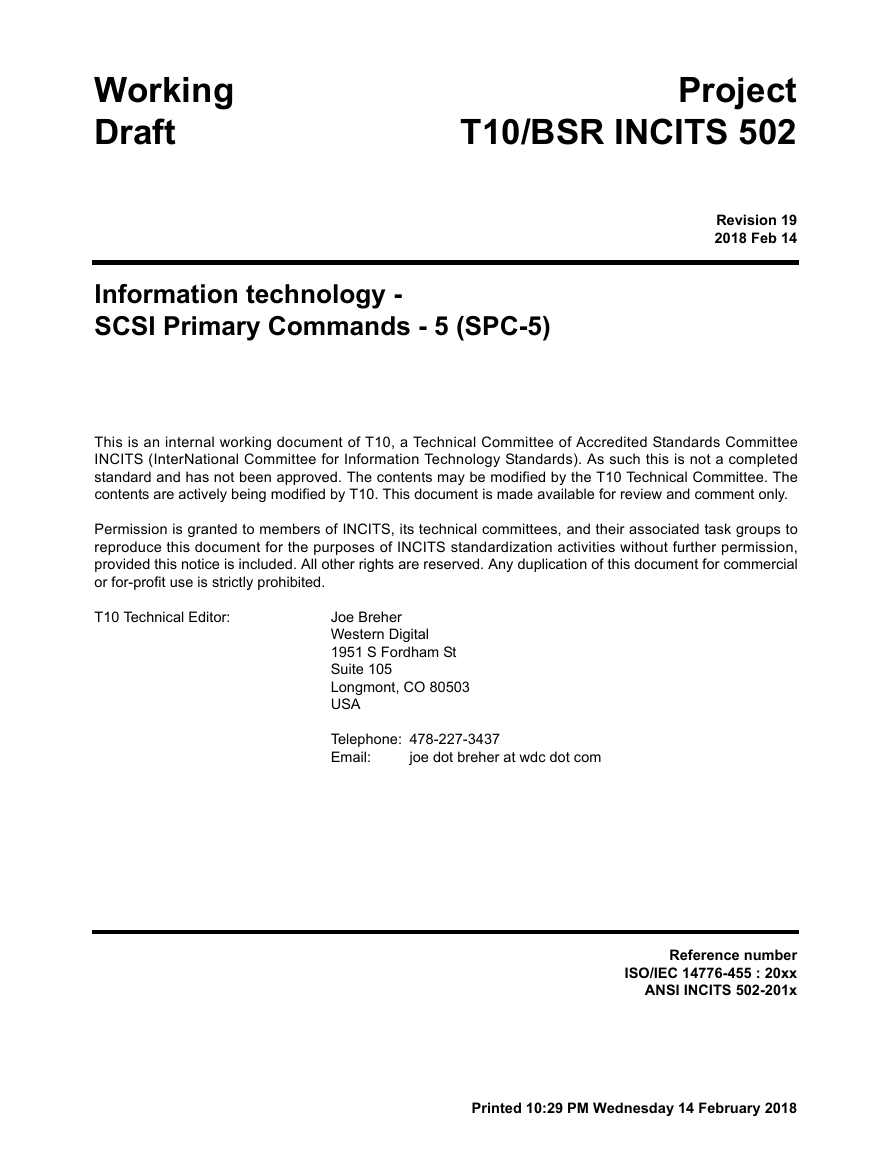
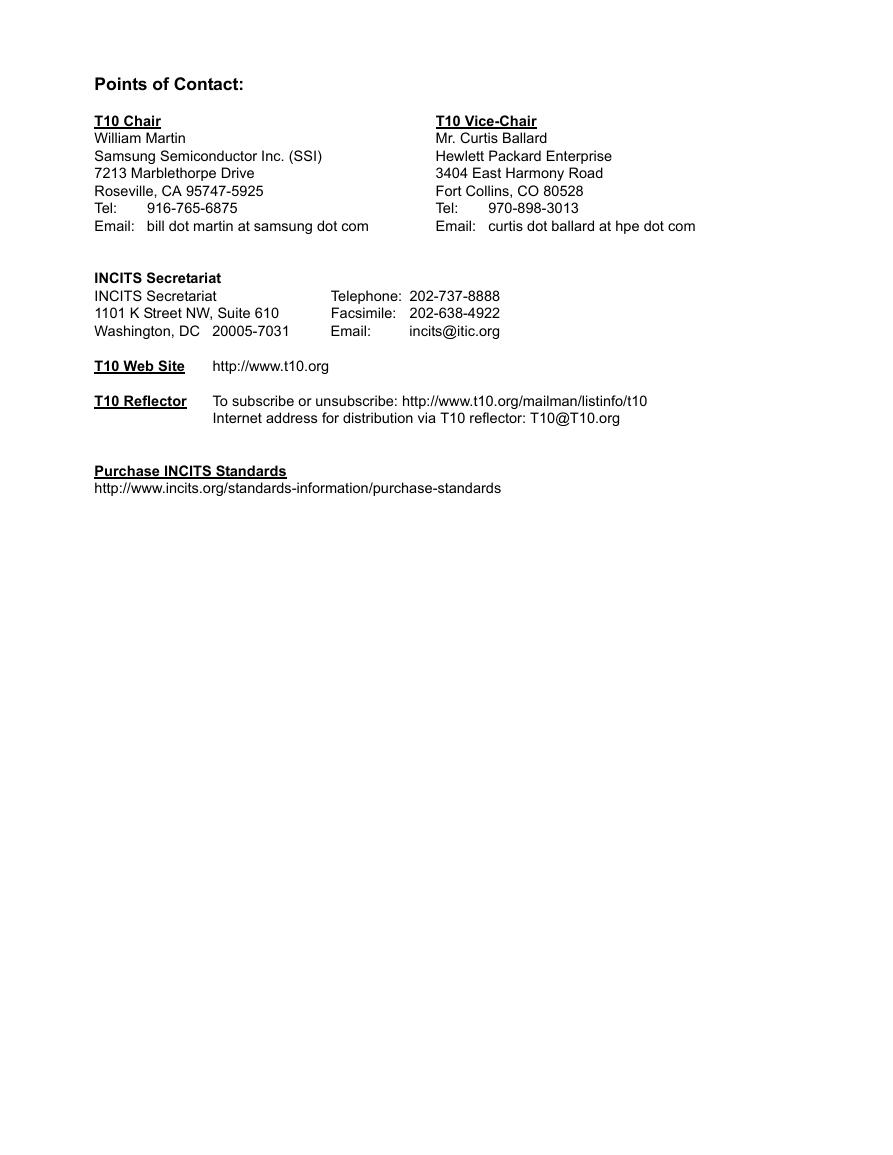
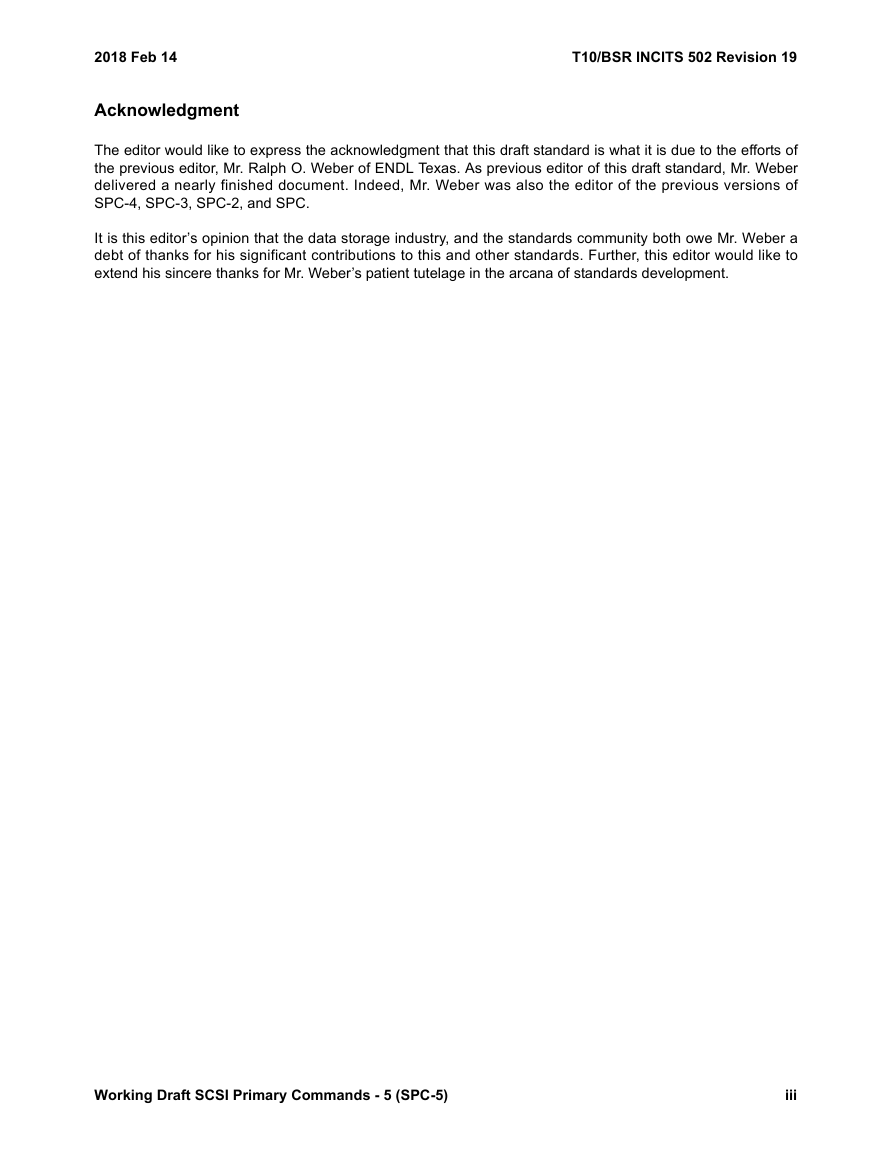
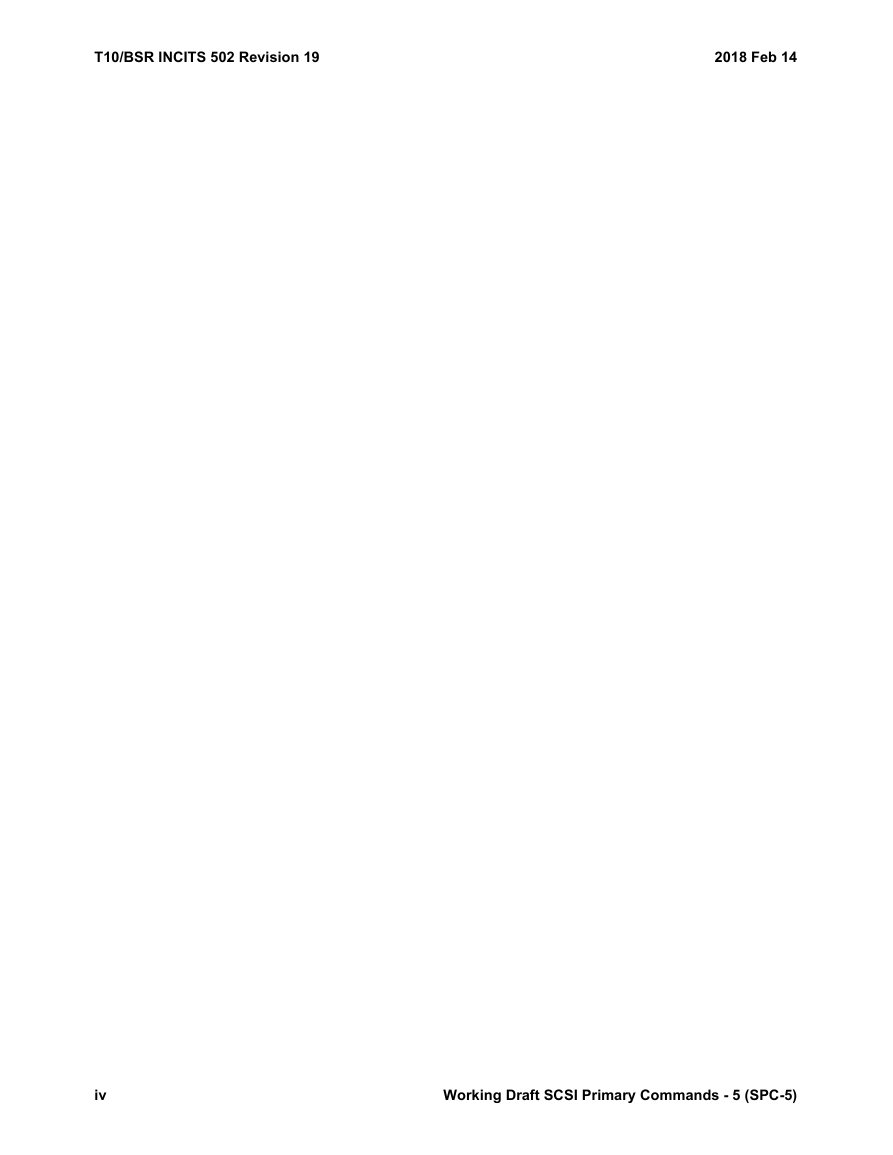
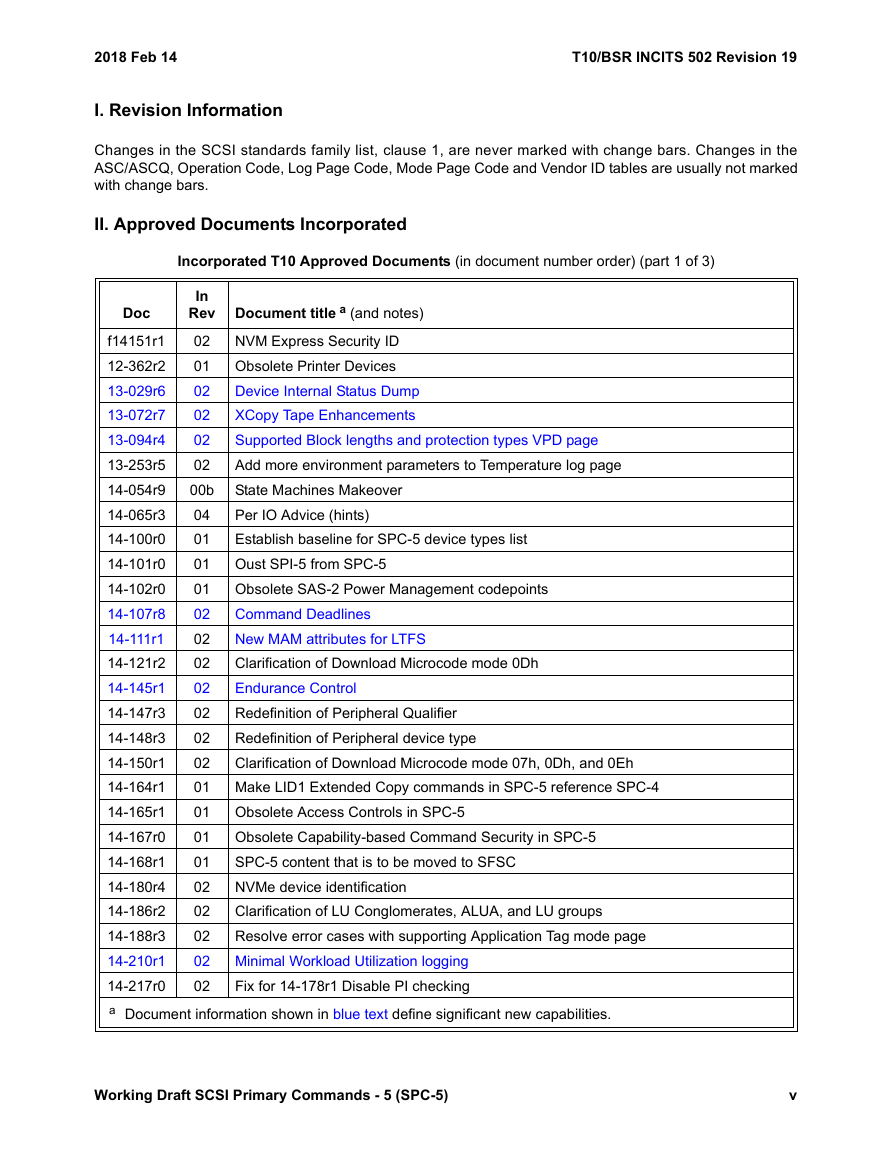

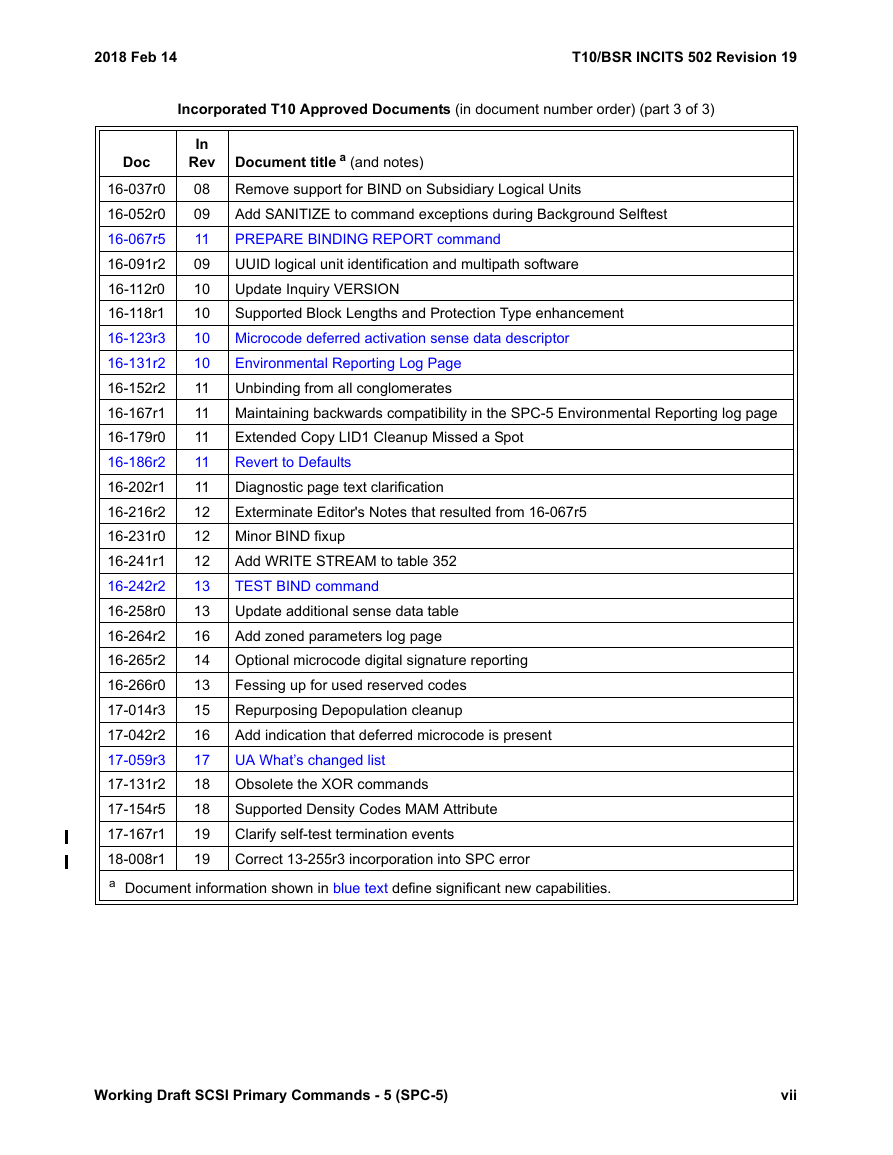
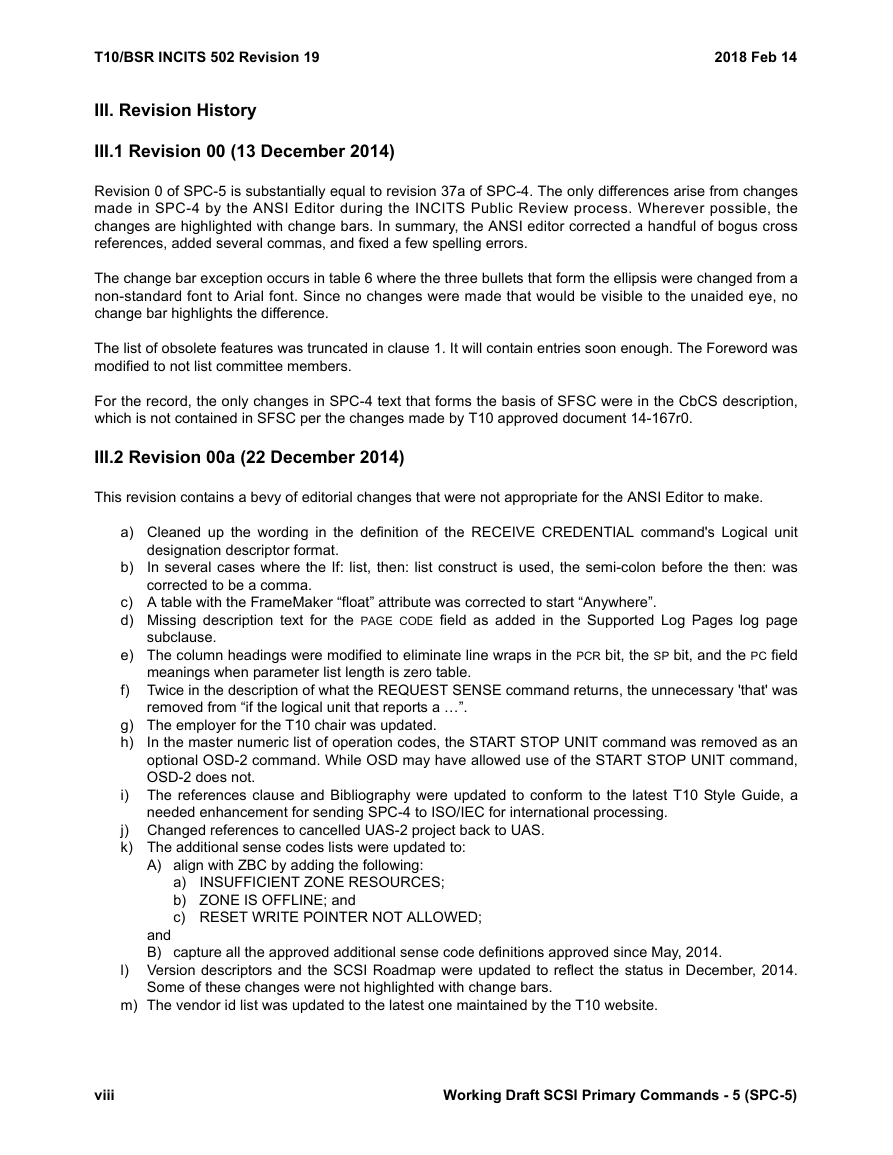








 2023年江西萍乡中考道德与法治真题及答案.doc
2023年江西萍乡中考道德与法治真题及答案.doc 2012年重庆南川中考生物真题及答案.doc
2012年重庆南川中考生物真题及答案.doc 2013年江西师范大学地理学综合及文艺理论基础考研真题.doc
2013年江西师范大学地理学综合及文艺理论基础考研真题.doc 2020年四川甘孜小升初语文真题及答案I卷.doc
2020年四川甘孜小升初语文真题及答案I卷.doc 2020年注册岩土工程师专业基础考试真题及答案.doc
2020年注册岩土工程师专业基础考试真题及答案.doc 2023-2024学年福建省厦门市九年级上学期数学月考试题及答案.doc
2023-2024学年福建省厦门市九年级上学期数学月考试题及答案.doc 2021-2022学年辽宁省沈阳市大东区九年级上学期语文期末试题及答案.doc
2021-2022学年辽宁省沈阳市大东区九年级上学期语文期末试题及答案.doc 2022-2023学年北京东城区初三第一学期物理期末试卷及答案.doc
2022-2023学年北京东城区初三第一学期物理期末试卷及答案.doc 2018上半年江西教师资格初中地理学科知识与教学能力真题及答案.doc
2018上半年江西教师资格初中地理学科知识与教学能力真题及答案.doc 2012年河北国家公务员申论考试真题及答案-省级.doc
2012年河北国家公务员申论考试真题及答案-省级.doc 2020-2021学年江苏省扬州市江都区邵樊片九年级上学期数学第一次质量检测试题及答案.doc
2020-2021学年江苏省扬州市江都区邵樊片九年级上学期数学第一次质量检测试题及答案.doc 2022下半年黑龙江教师资格证中学综合素质真题及答案.doc
2022下半年黑龙江教师资格证中学综合素质真题及答案.doc